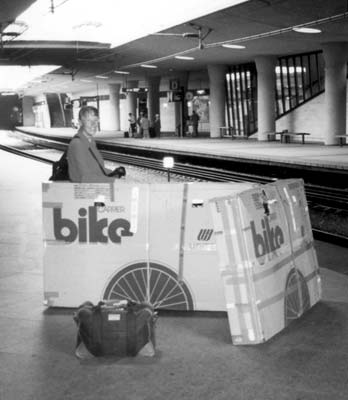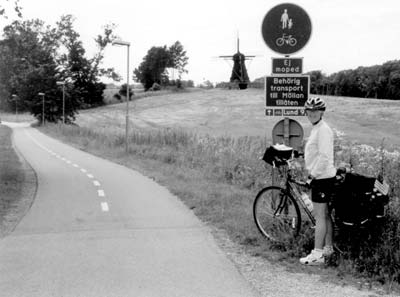Cycling in Sweden
The upside of high gasoline prices in Sweden is that it encourages people to bike to school, work or shops. And since southernmost Sweden, the region known as Skane, has so many cyclists, it has developed an extensive system of bike lanes and trails, including converted rail lines, to accommodate them. That plus terrain ranging from level ground to rolling hills makes Sweden an unusually bike-friendly country. Another plus for travelers — English is almost a second language there.
My husband, Fred, and I have taken up cycling in our retirement, and since we have relatives in Lund we decided to make a bike tour of Skane. We took our trip in June ’02, but in late 2005 I updated all of the information for this report to ITN.
When we were planning our adventure, we had a hard time getting tourist information in English via the Web, but now the site www.skane.com has a link to such info in English, listing shops renting bicycles and providing details on bike touring in Sweden. The site www.bopalantgard.org lists farmstay accommodations.
Using the Web to locate the tourist bureaus for some of the towns we planned to visit, we ordered a cycling map of Skane and a brochure from Osterlen, the southeast corner of Skane.
After roughly planning our itinerary, we ordered a 1:100,000-scale map of Malmö, titled “Bla Karten (Blue Maps) No. 31,” from the company Lantmateriet (visit www.lantmateriet.se, looking first under “Map Store,” then “National map series,” then “Vagkarten” [“Way Maps”]). This map showed many of the cycle paths and had more detail than the above cycling map of Skane.
We used the Web and the Lonely Planet Guide “Sweden” to locate lodgings along our route and booked via the Web or by fax. B&Bs ran about $60 and the hotels about $80 a night for two.
At the time, we were unable to find good touring bikes (with panniers) to rent, but we learned we could take our own bikes on United and SAS Scandinavian airlines at no extra cost. Boxed up, they each were our second pieces of luggage.
We bought two bike boxes at $10 each (same price in 2005) at the United Airlines ticket counter and took them home to pack up our bikes. (You need to call the United desk at your airport ahead of time and pick up the boxes as they are not always available.)
To pack the bicycles, we removed the pedals, turned handlebars sideways, attached our empty panniers to the bikes and rolled them into the box. There was space for our helmets and water bottles, so we put those into the box too. Obviously, dedicated bike luggage from a cycling shop would be preferable, but the great difference in cost encouraged us to give the box method a try.
Our flight (then $875 each round trip) went direct from Washington/Dulles International to Copenhagen, Denmark. The bikes survived the trip in good condition.
The ticket office and train to Malmö, Sweden, were only a short walk from the luggage pickup area, so we bought our tickets with a credit card (at the time, $35 round trip for two) and dragged our boxes to the platform and then onto the train. The train had a middle car whose door was level with the platform, making boarding with the bike boxes simple.
We could have unpacked and reassembled the bikes, as the luggage area of the Copenhagen airport was well equipped for bike assembly with wall racks and an air pump; however, we learned that when the bike is in a box, it is luggage and rides free. If your bicycle is unpacked, there is a small extra charge (about $4) and you must buy a ticket for your bicycle when booking your fare.
In either case, you have to save your bike box, since none are available for the return trip. (The boxes were in bad shape after the return flight, so we would never use them for a multileg trip.)
The train trip across the Øresund Bridge/tunnel lasted 20 minutes and deposited us in Malmö. Our relatives from Lund picked us up at the train station and stored our baggage while we went on our week-long ride.
After arriving in Sweden, we found that the local tourist bureaus had booklets listing many more accommodations than we had found on the Web. (The new website www.skane.com with its links to the local tourist bureaus now has more complete listings than before, including campgrounds and hostels.)
Our route took us south from Lund, through Malmö and down to the port town of Trelleborg. The next day, we biked mainly along the coast to Ystad, and from there, again skirting the coast or passing quiet pastureland, we biked on to Brantevik, a small village on the coast just south of Simrishamn. We stayed two nights there so we could spend a day biking around some of the old farm villages and visiting a 16th-century fortress, Glimmingehus, as well as touring the postcard-pretty town of Simrishamn.
We then headed north along the coast to Yngsjö and inland to the village of Everod. The next day, our only rainy day, we made directly for Horby, where we stayed on a small sheep farm. The route for our last day took us south through the nature preserve at Krankesjon and then over to Sandby, where the bike path follows an old rail line into Lund. We celebrated the completion of our trip with coffee and pastry in the old square in central Lund before picking up the bike trail back to our relatives’ subdivision south of town.
Food and services were never a problem on our trip. Breakfasts at our lodgings were more than ample. Lunch consisted of fruit, bread and cheese purchased from stores along the way. Local restaurants provided ample, reasonably priced, well-prepared evening meals. At the sheep farm, the owner prepared us lamb stew in the evening, which was a real treat.
Skane is characterized by small fishing villages, farms, windmills, castles and neat old towns. For the most part, our route tended to follow marked bike routes or paths, so we were “off the beaten path” and avoided road traffic. We had to use some roads to make connections and found that most had shoulders, plus the drivers were used to seeing cyclists.
The prevailing wind blows west to east in the summer, which made the first legs of our adventure a “breeze,” though the trip back was a challenge. We generally covered about 35 miles a day, which made for easy rides with time for touring. We had rain one day, but otherwise the weather was cool and sunny.
Considering what a pleasant bicycling area Skane is, we were surprised at how few touring cyclists were there. We met only a few other folks, mostly Germans, who were making a similar circuit.
We felt our Scandinavian adventure was unhurried and relaxing and worked out well. We hope to try a repeat in the near future.
ANN ABELES
Frederick, MD


